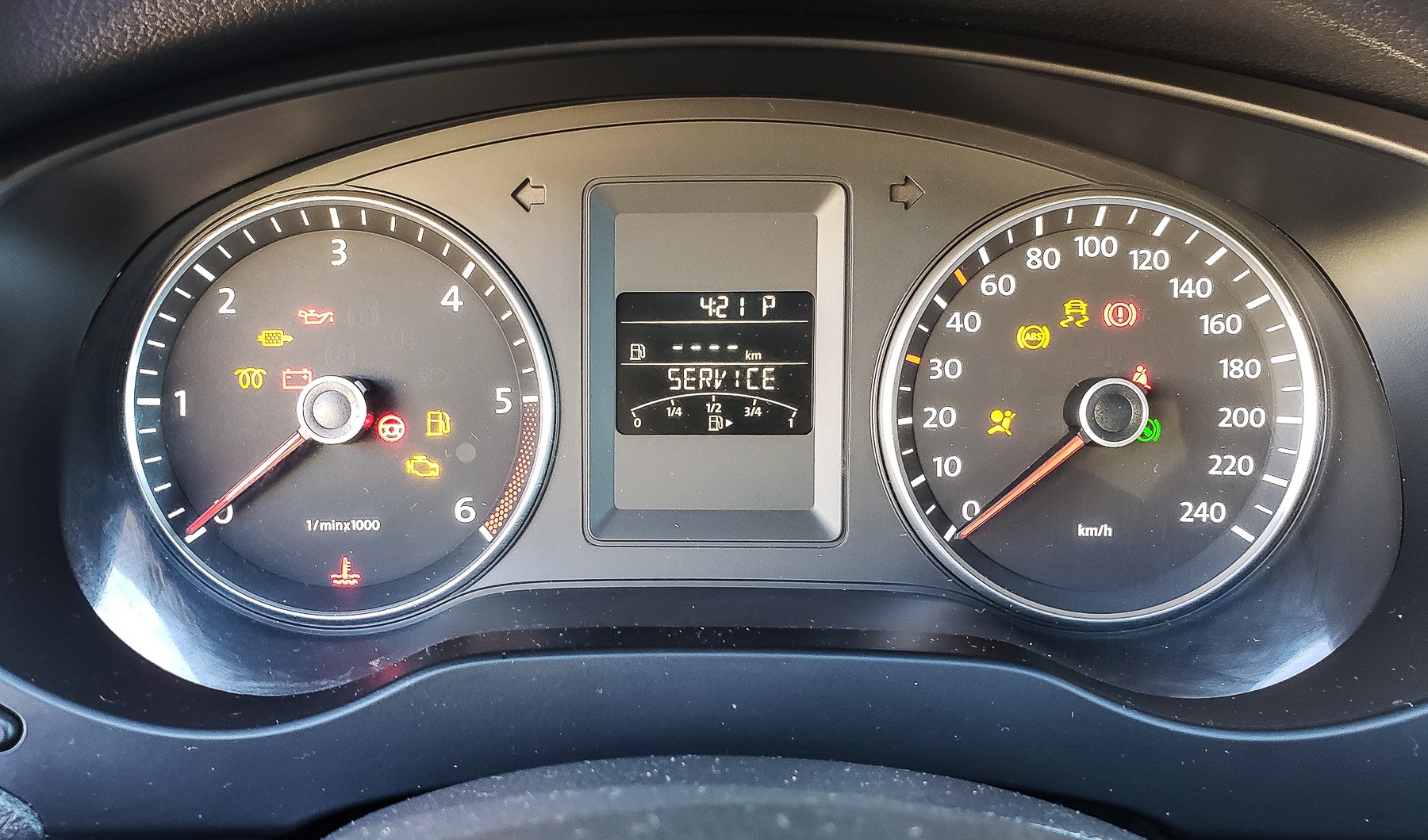Dashboard warning lights are crucial indicators of your vehicle’s health, and understanding them can save you from costly repairs and ensure your safety on the road. For owners of a 2012 Vw Jetta Diesel, deciphering these symbols is especially important to maintain the longevity and performance of their TDI engine. This guide, brought to you by the experts at keyfobprog.com, will break down the most common warning lights you might encounter in your 2012 VW Jetta Diesel.
We’ll delve into the meaning behind each light, differentiating between the urgent red warnings and the cautionary amber signals. Remember, while some lights indicate minor issues, others require immediate attention to prevent serious damage. Ignoring these signals can lead to bigger problems down the road.
Understanding Warning Light Colors: Red vs. Amber
Before we dive into specific symbols, it’s essential to grasp the color-coding system used for dashboard warning lights. Generally, lights are categorized into two primary colors:
-
Red: Red lights signal serious issues that require immediate attention. They often indicate problems that could cause significant damage or compromise safety. Think of red as a “stop” sign – it’s crucial to address these warnings promptly.
-
Amber (Yellow): Amber or yellow lights are cautionary signals. They indicate a potential problem or a system malfunction that needs to be checked, but it’s usually not as critical as a red light. Amber lights are more like “yield” signs – they suggest caution and the need for inspection soon.
There are also other colors like green and blue, which are typically informational lights and not warnings. For example, the blue high beam indicator or green turn signal indicators.
Decoding the 2012 VW Jetta Diesel Dashboard Symbols
Let’s explore the dashboard warning lights specific to a 2012 VW Jetta Diesel, starting from the right side of the instrument cluster and moving left.
Right Side Warning Lights
-
Airbag Warning Light (Amber): This light, often resembling a person with a deployed airbag, indicates a malfunction in the Supplemental Restraint System (SRS), commonly known as the airbag system. A fault here means your airbags might not deploy correctly in an accident. It’s crucial to have this system diagnosed by a professional technician to ensure passenger safety.
-
ABS Warning Light (Amber): The “ABS” light signals an issue with the Anti-lock Braking System. While your regular brakes will still function, the ABS, which prevents wheel lock-up during hard braking, might be disabled. This can be especially risky in slippery conditions. Prompt inspection is recommended to restore full braking functionality.
-
Traction Control System (TCS) Warning Light (Amber): Usually depicted as a car skidding or the letters “ESP” (Electronic Stability Program) or “TCS”, this light indicates a problem with the traction control system. Sometimes this light might flicker briefly during normal driving, especially on slippery surfaces, as the system engages to prevent wheel spin. However, a constant illumination suggests a malfunction requiring attention. The TCS helps maintain control by reducing engine power or applying brakes to individual wheels when wheel slip is detected.
-
Brake Warning Light (Red/Amber): This light, often an exclamation point inside a circle and parentheses, is multi-functional. In red, it can mean:
- Parking Brake Engaged: The most common reason. Ensure your parking brake is fully released.
- Low Brake Fluid Level: If the parking brake is off and the light remains red, it indicates low brake fluid, which is a serious safety concern. Check your brake fluid reservoir level immediately and look for any leaks. Low brake fluid can severely impair braking performance.
In some cases, this light might also appear amber for less critical brake system issues. Always consult your owner’s manual for the specific meaning in your 2012 VW Jetta Diesel.
-
Seatbelt Warning Light (Red): A straightforward reminder, this red light illuminates when the driver or passenger seatbelts are not fastened. It’s a crucial safety feature, emphasizing the importance of wearing seatbelts at all times while driving.
-
“Brake Pedal” Indicator (Green): This light, often showing a foot pressing a pedal, is an informational light, not a warning. It illuminates to remind the driver to press the brake pedal when shifting out of “Park” (P) position, especially in automatic transmissions. It should turn off once the brake pedal is pressed and you shift gears.
Left Side Warning Lights
-
Check Engine Light (CEL) / Malfunction Indicator Lamp (MIL) (Amber): Perhaps the most ambiguous warning light, the “Check Engine” light (often shaped like an engine or the words “Check Engine”) can indicate a wide range of issues related to the engine or emissions system. For a 2012 VW Jetta Diesel, this could be anything from a loose gas cap (though less relevant for diesel), a faulty sensor, to more serious engine problems.
- Solid CEL: Indicates a problem that needs attention but is generally not immediately critical. Schedule a diagnostic check soon.
- Flashing CEL: A flashing check engine light is more serious, often indicating a catalyst-damaging misfire. While less common in diesels compared to gasoline engines, a flashing CEL in a 2012 VW Jetta Diesel should be addressed urgently to prevent potential damage to the catalytic converter or other components.
-
Low Fuel Warning Light (Amber): Shaped like a fuel pump or gas can, this light simply indicates that your fuel level is low and you need to refuel soon. While not a mechanical problem, running out of fuel can leave you stranded.
-
Glow Plug Indicator Light (Amber): Unique to diesel engines like the TDI in your 2012 VW Jetta Diesel, the glow plug light (often resembling a coiled wire) illuminates when you turn the ignition key to the “ON” position. Glow plugs preheat the engine cylinders to aid in cold starting. The light should turn off after a few seconds (longer in cold weather) when the glow plugs have sufficiently warmed the cylinders, and you can then start the engine.
- Prolonged Illumination or Flashing After Engine Start: If the glow plug light stays on for an extended period after starting or flashes while driving, it indicates a problem with the glow plug system that requires diagnosis.
-
Diesel Particulate Filter (DPF) Warning Light (Amber): This light, often resembling a box with dots inside, indicates that the Diesel Particulate Filter, a crucial component in modern diesel engines to reduce soot emissions, is becoming clogged with soot. Your 2012 VW Jetta Diesel is equipped with a DPF.
- DPF Light On: Often, the vehicle can regenerate the DPF by driving at highway speeds for a period, allowing the exhaust system to heat up and burn off the accumulated soot.
- Continued Illumination or Additional Warnings: If the light persists or is accompanied by other warning lights, it might indicate that the DPF is severely clogged or there’s an underlying issue requiring professional servicing. Ignoring this can lead to reduced engine performance or the need for expensive DPF replacement.
-
Engine Temperature Warning Light (Red): Shaped like a thermometer submerged in liquid, this red light is critical. It warns of engine overheating. If this light comes on, safely pull over immediately, turn off the engine, and allow it to cool down. Overheating can cause severe engine damage. Check coolant levels (once the engine has cooled down) and seek professional assistance to diagnose the cause of overheating.
-
Oil Pressure Warning Light (Red): Shaped like an oil can, this red light is another critical warning. It indicates critically low engine oil pressure. If this light illuminates while driving, stop immediately and turn off the engine. Running the engine with low oil pressure can cause rapid and severe engine damage. Check your oil level and consult a mechanic to diagnose the cause of oil pressure loss.
-
Battery Warning Light (Red): Depicted as a battery symbol, this red light indicates a problem with the charging system, not necessarily the battery itself. It usually means the alternator is not charging the battery properly. If this light comes on while driving, your car is likely running solely on battery power. While you might be able to drive for a short distance, the battery will eventually drain, and the car will stall. Have the charging system inspected promptly.
-
Power Steering Warning Light (Red/Amber): Often shaped like a steering wheel with an exclamation point, this light indicates a fault in the power steering system. 2012 VW Jetta Diesel models typically use electric power steering.
- Red Light: May indicate a complete power steering failure, making steering significantly harder.
- Amber Light: Could indicate a less severe issue, but still warrants investigation. While you can still steer the vehicle, the increased effort, especially at low speeds, can be challenging and potentially unsafe in emergency maneuvers.
What to Do When a Warning Light Comes On
When a warning light illuminates in your 2012 VW Jetta Diesel, your first step should be to consult your owner’s manual. It provides specific information about each warning light and recommended actions for your vehicle model.
Here are general guidelines:
-
Identify the Color: Red lights generally demand immediate action. Amber lights signal a need for attention soon.
-
Check Your Manual: Your owner’s manual is the best resource for understanding the specific meaning of each light in your 2012 VW Jetta Diesel.
-
Assess the Situation: Consider if the light is accompanied by any noticeable symptoms like unusual noises, smells, or changes in driving performance.
-
Take Action:
- Red Lights (Critical): For critical red lights like engine temperature, oil pressure, or brake fluid, safely pull over and stop the car as soon as possible. Turn off the engine and allow it to cool down if overheating. Do not continue driving if it indicates a serious issue. Call for roadside assistance or a trusted mechanic.
- Amber Lights (Cautionary): Amber lights indicate a problem that needs addressing but is usually not an immediate emergency. Schedule a service appointment with a qualified mechanic to diagnose and repair the issue. Don’t ignore amber lights, as they can sometimes escalate into more significant problems if left unattended.
-
Seek Professional Help: If you are unsure about the meaning of a warning light or how to proceed, it’s always best to consult a certified mechanic. Professionals at shops like Pawlik Automotive (referenced in the original article) specialize in vehicles like your 2012 VW Jetta Diesel and can accurately diagnose and repair any issues.
Maintaining Your 2012 VW Jetta Diesel
Regular maintenance is key to preventing many warning lights from appearing in the first place. Following the recommended maintenance schedule for your 2012 VW Jetta Diesel, including oil changes, fluid checks, and timely inspections, can help ensure your vehicle remains reliable and avoids unexpected breakdowns.
Understanding your 2012 VW Jetta Diesel warning lights empowers you to be a more informed driver and proactively maintain your vehicle’s health, contributing to safer and more enjoyable driving experience.


